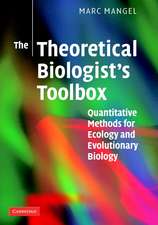Modeling Biological Systems:: Principles and Applications
Autor James W. Haefneren Limba Engleză Hardback – 6 mai 2005
| Toate formatele și edițiile | Preț | Express |
|---|---|---|
| Paperback (2) | 738.16 lei 6-8 săpt. | |
| Springer Us – 4 dec 2014 | 738.16 lei 6-8 săpt. | |
| Springer Us – 16 oct 2012 | 953.97 lei 6-8 săpt. | |
| Hardback (2) | 778.98 lei 6-8 săpt. | |
| Springer Us – 6 mai 2005 | 778.98 lei 6-8 săpt. | |
| Springer Us – 31 iul 1996 | 806.73 lei 39-44 zile |
Preț: 778.98 lei
Preț vechi: 949.98 lei
-18% Nou
Puncte Express: 1168
Preț estimativ în valută:
149.06€ • 155.95$ • 123.82£
149.06€ • 155.95$ • 123.82£
Carte tipărită la comandă
Livrare economică 03-17 aprilie
Preluare comenzi: 021 569.72.76
Specificații
ISBN-13: 9780387250113
ISBN-10: 0387250115
Pagini: 475
Ilustrații: XI, 475 p.
Dimensiuni: 155 x 235 x 36 mm
Greutate: 1.92 kg
Ediția:2nd ed. 2005
Editura: Springer Us
Colecția Springer
Locul publicării:New York, NY, United States
ISBN-10: 0387250115
Pagini: 475
Ilustrații: XI, 475 p.
Dimensiuni: 155 x 235 x 36 mm
Greutate: 1.92 kg
Ediția:2nd ed. 2005
Editura: Springer Us
Colecția Springer
Locul publicării:New York, NY, United States
Public țintă
ResearchCuprins
Principles.- Models of Systems.- The Modeling Process.- Qualitative Model Formulation.- Quantitative Model Formulation: I.- Quantitative Model Formulation: II.- Numerical Techniques.- Parameter Estimation.- Model Validation.- Model Analysis: Uncertainty and Behavior.- Stochastic Models.- Applications.- Photosynthesis and Plant Growth.- Hormonal Control in Mammals.- Populations and Individuals.- Chemostats.- Diseases.- Spatial Patterns and Processes.- Scaling Models.- Chaos in Biology.- Cellular Automata and Recursive Growth.- Evolutionary Computation.
Textul de pe ultima copertă
This extensively revised second edition of Modeling Biological Systems: Principles and Applications describes the essentials of creating and analyzing mathematical and computer simulation models for advanced undergraduates and graduate students. It offers a comprehensive understanding of the underlying principle, as well as details and equations applicable to a wide variety of biological systems and disciplines. Students will acquire from this text the tools necessary to produce their own models.
The text contains two major sections: Principles and Applications. The first section discusses the principles of biological systems with a thorough description of the essential modeling activities of formulation, implementation, validation, and analysis. These activities are illustrated by a set of example models taken from recent and classical literature, chosen for their breadth of coverage and current timeliness. The new edition updates extensively many of these topics, especially quantitative model formulation, validation and model discrimination using information theory measures and Bayesian probability, and stability analysis and non-dimensionalization.
The text contains two major sections: Principles and Applications. The first section discusses the principles of biological systems with a thorough description of the essential modeling activities of formulation, implementation, validation, and analysis. These activities are illustrated by a set of example models taken from recent and classical literature, chosen for their breadth of coverage and current timeliness. The new edition updates extensively many of these topics, especially quantitative model formulation, validation and model discrimination using information theory measures and Bayesian probability, and stability analysis and non-dimensionalization.
Caracteristici
More rigorous and mathematical than the competitive titles, which are intended for a less sophisticated reader In an active and growing area, and the fact that it is a single author text is also an advantage
Recenzii
Throughout the book, the author aims to teach the concepts of mathematical modelling by example, allowing a full understanding of how and why mathematics is so important in biology. This is a superb introduction and complements the more technical literature... - The Biologist;
Covers a broad area with wit and enthusiasm, tempered with an appropriate degree of caution...a valuable introduction...a balanced selection of references makes this a handy source text for those seeking to learn more. - Journal of Animal Ecology;
The book will be useful for those readers who want to get a survey of the use of various types of models in biology. - Eur. Jnl. of Entomology, 1997;
This is an excellent book for the student who wants a mathematical model but does not know how to construct one - Journal of Experimental Marine Biology and Ecology.
Covers a broad area with wit and enthusiasm, tempered with an appropriate degree of caution...a valuable introduction...a balanced selection of references makes this a handy source text for those seeking to learn more. - Journal of Animal Ecology;
The book will be useful for those readers who want to get a survey of the use of various types of models in biology. - Eur. Jnl. of Entomology, 1997;
This is an excellent book for the student who wants a mathematical model but does not know how to construct one - Journal of Experimental Marine Biology and Ecology.
















